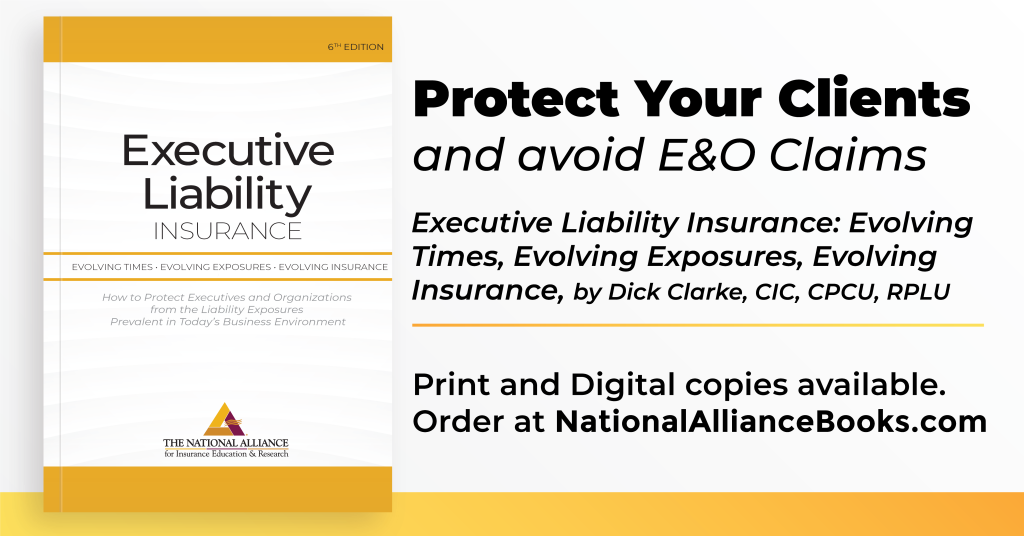By Dwight M. Kealy, J.D., MA, CIC, AAI
In the tumult of our modern public discourse, do you ever wonder how someone can blatantly tell a mistruth about another person, and get away with it? Truth be told, if you say or write a false defamatory statement of fact about someone else, you could get sued, and your Commercial General Liability Policy could possibly provide you with a defense and pay damages under Coverage B, “Personal and Advertising Injury.”
The Coverage B insuring agreement states that “This insurance applies to ‘personal and advertising injury’ caused by an offense arising out of your business but only if the offense was committed in the ‘coverage territory’ during the policy period.” The definition of “Personal and Advertising Injury” is limited to seven named offenses. One of these seven offenses is the “oral or written publication, in any manner, of material that slanders or libels a person or organization or disparages a person’s or organization’s goods, products or services.” Slander and libel are both forms of the tort of defamation. Slander occurs when the defamation is oral. Libel occurs when the defamation is in writing. Defamation exists when one communicates a 1) false, 2) defamatory, 3) statement of fact, of or concerning the plaintiff, and 4) publishes it to a third party. Let us look at each of these.
1) Falsity: Notice that the first element of defamation is that the published statement has to be false. If what someone says is true, it is not defamation no matter how bad the statement is.
2) Defamatory: You might not like people talking about you. This might be especially true if what people are saying is not true. However, people saying untrue things about you will only meet the definition of the tort defamation if what the people are saying is considered defamatory. To be defamation, the statement would have to be one that would subject the plaintiff to scorn or ridicule, or lower the plaintiff’s reputation in the eyes of a respectable minority of the community.
3) Statement of fact, of or concerning the plaintiff: You might eat at a restaurant tonight, lean over to the table next to you and say, “This meat tastes like rat meat.” I hope this is false, satisfying the first element of defamation. I think the restaurant owner would find this defamatory, satisfying the second element. But what you are saying will not be defamation because you are not communicating a statement of fact. You are offering your opinion. If, on the other hand, you lean over to the table next to you and say, “Don’t order the spaghetti because this restaurant uses rat meat in its marinara sauce,” now you have made a statement of fact of or concerning the restaurant. The requirement that the statement be a statement of fact eliminates statements that are opinions, exaggerations, and jokes. Many of the negative business reviews posted on social media have avoided litigation based on this element. So long as the customer is offering an opinion and not fabricated false defamatory facts, the customer will not be found liable for defamation. However, when reviewers move beyond opinion and offer false defamatory facts, they may be found liable for defamation.
4) Published to a third party: For a statement to be libel or slander, the statement must be published to a third party. When we think of publishing, we often think of books and things that are printed. Remember, defamation can also be oral (slander), and so the publishing requirement does not refer exclusively to printing. A statement is published to a third party when the party committing the defamation causes a third party to see or hear the false defamatory statement of fact. The third party can be anyone other than the person or entity about which the statement is made. If you tell the owner of our hypothetical restaurant that he is using rat meat, that is not defamation. You are not communicating the statement to a third party. You are communicating it directly to the restaurant owner. A statement is only defamation if it is communicated to a third party.
At this point, you may be thinking that there must be limitations to what defamation the CGL Policy will cover and who can be sued for defamation, or we would see defamation lawsuits every day. Indeed, there are limitations on what the U.S. Supreme Court has decided is defamation and provisions that determine when the CGL Policy will pay damages for defamation.
The Supreme Court case, New York Times Co. v. Sullivan, 376 U.S. 254 (1964), changed defamation litigation in the United States. This case arose after the New York Times printed an advertisement soliciting funds for Martin Luther King, Jr. The advertisement stated that the Alabama police had arrested Dr. King seven times. In fact, he had been arrested four times. According to L.B. Sullivan of Montgomery, Alabama, this was a false defamatory statement of or concerning him because he was the Public Safety Commissioner at the time. An Alabama state court agreed, awarding Sullivan $500,000 in a defamation case against the newspaper.
The concern after this decision was that the press might be reticent to publish newsworthy stories because of the threat of litigation from government officials. It was feared that this could have a chilling effect on the 1stAmendment right to a free press. Because of its importance, the case was accepted by the Supreme Court, and the Alabama court’s decision was overturned. The Times v. Sullivan decision clarified that, “the 1st Amendment protects the publication of all statements, even false ones, about the conduct of public officials except when statements are made with actual malice (with knowledge that they are false or in reckless disregard of their truth or falsity).” This precedent makes it unlikely that public officials will win in a defamation lawsuit against the press unless the press knew the statement was false or showed reckless disregard to the truth or falsity of the statement. Later cases extended this standard not only to public officials, but to matters of public concern, as well. Consequently, individuals will avoid defamation for false statements against public officials or on matters of public concern unless the statements are made by someone who knows the statements are false, or who shows reckless disregard to whether the statements are true
or false.
This standard has been tested lately in the public discourse concerning the appointment of a new Supreme Court Justice. Accusations were made against the nominee. Then, accusations were made against his accusers. Then social media exploded with what was, at times, false, defamatory statements of fact against these people—both the nominee and his accusers. The conduct of a Supreme Court Justice is clearly a matter of public concern, which means that someone could only be found liable for defamation if the person who made the statement showed malice. With no corroborating facts, making these types of statements could satisfy the malice standard because of a reckless disregard to truth or falsity.
The most important Coverage B exclusion relating to defamation is Exclusion b. Material Published with Knowledge of Falsity. If the statement is made against a public official or matter of public concern, it will only be defamation if the statement is made with knowledge of falsity or reckless disregard to its truth or falsity, and the CGL Policy will not defend or pay damages if the person making the statement knew it was false. It is only in the window of a statement showing reckless disregard to the truth or falsity where the CGL Policy may get involved to defend or pay damages relating to defamation against a public official or on a matter of public concern.
For statements about private persons that are not matters of public concern, we do not need to see reckless disregard to the truth or falsity. So long as the statement is false, defamatory, of or concerning the plaintiff, and published to a third party, the CGL Policy should respond if the person who made the statement did not know the statement was false.
The CGL Policy also excludes J. Insureds in the Media and Internet Type Business and K. “personal and advertising injury” arising out of an electronic chat room or bulletin board the insured hosts, owns, or over which the insured exercises control. Insureds in the media and internet-type businesses or those who host, own or exercise control over chat rooms or bulletin boards should seek specific policies to address their potential liabilities.
A case can be made that with the seeming anonymity of the internet and the spontaneity of Twitter, Instagram, and other social media platforms that can instantly spark a heated no-holds-barred exchange, we have become dulled to the simple importance of taking time to know the facts and to consider what we say. Defamation litigation still exists. If precision of speech and accuracy in public discourse are to be thrown out the door, individuals may be sued for making false statements, and their CGL Policy may come to the rescue, providing a safety net for holders through its window of specified provisions.
About the Author: Dwight M. Kealy, J.D., MA, CIC, AAI
Dwight Kealy is an Attorney as well as a CISR Faculty member, CISR Mentor, and a National CIC Faculty member. He has spent more than a decade in the commercial insurance industry where he was Chief Operations Officer/VP for one of California’s largest insurance agencies for contractor’s liability insurance.
Dwight is the author of several books and articles on commercial insurance. He has been a member of the American Bar Association’s Tort Trial and Insurance Practice Section, a member of the American Bar Association’s Forum on the Construction Industry, and has a 10 out of 10 rating with the attorney rating site, avvo.com.














































